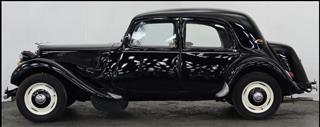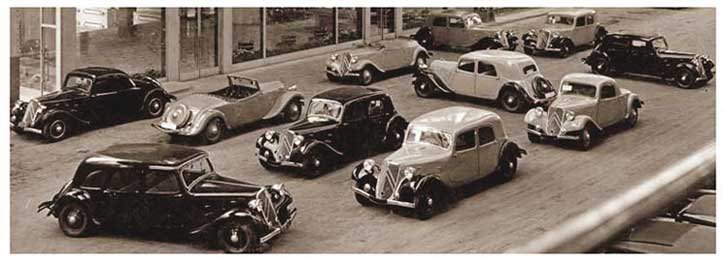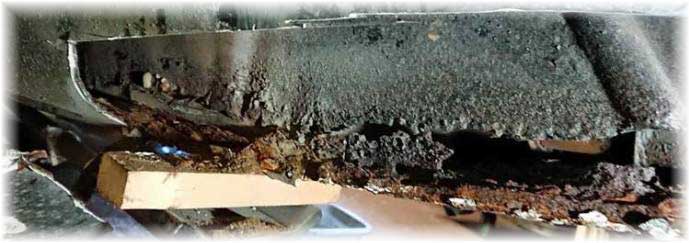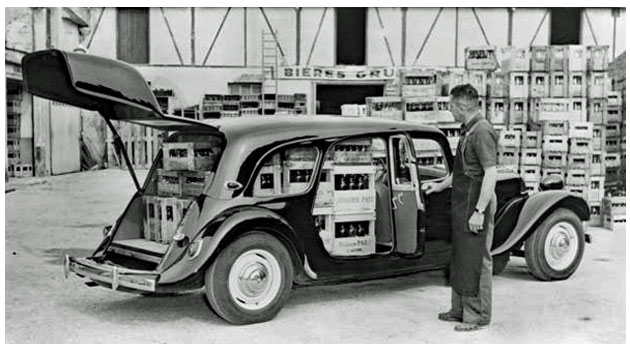

Traction Avant Buyers GuideThere were a number of Traction Avant variants over the years, with a large range of engines and body styles. Citroën started building Tractions in 1934 and continued until 1957 when the Traction Avant ceased production. This guide is a summary of what to look out for based on personal experience. The most common body style is a four-door saloon fitted with 1.9-litre engines in four-cylinder form and they are not as expensive to acquire compared to some other 'classics' varying from £4,000 for a 'Barn Find' in France to £30,000 for a restored 15/6 in the UK. Depending on how deep your pockets are, there are other variants, e.g. a two-door sedan and coupe, two-door convertible and the first ever five-door hatchback. There is an even a longer length ‘Familiale’ version with seating for 9 which are often found being used as 'Wedding Cars'. A basic Guide to the different types: (some images of Traction Variants )
However be aware that all may not be what they seem and those expensive 'roadsters' in particular may not be originals, but converted saloons made mostly in Asia which will significantly affect there value. 
The Traction Avant was known as the 7CV, 11CV and 15CV in France as well as receiving different names in England with the 11CV renamed the 15HP and 15CV called the ‘Big Six’. All cars had a three-speed manual transmission and shared similar running gear, except for the 1954 15H model (these are fairly rare though), which had an early version of the advanced hydropneumatic suspension ahead of its use in the replacement DS models. Despite popular belief, all Traction Avants were not all delivered in 'Black', Pre war, various colours were available and in the 1950's some cars came in Metallic paint.
The interiors also differ between French and English models. Typically French cars have metal dashboards and cloth interiors (left side of picture below) whilst Slough cars had a more 'luxurious' wooden dashboard and leather seats etc. as shown on the right in the image below. (Steering Wheel is non standard though a period accessory.) 
Small booted cars (Malle Plate) are more sought after than the post July 1952 Big Boot (Malle Bombe) cars. Beside the obvious difference at the rear of the car 1952 saw the 'moustache' bumpers on French cars replaced with straight ones and the windscreen wipers were moved from the top of the windscreen to the bottom. That makes opening the screen to allow airflow into the cabin more problematic.
BUYING A TRACTION, WHAT TO LOOK OUT FOR: BODYWORK & CHASSIS The biggest enemy of the Traction Avant is rust: Especially on Slough Built, Right Hand Drive Cars, which many have suffered from the ravages of UK salty winter roads. Some though were exported to South Africa and Australia and have since been brought back to the UK, so have survived better in the drier climate. If the monocoque is weakened, the car will sink ahead of the windscreen 'A' pillar, as the engine subframe gradually pulls away. The first place to check for corrosion are the sills and the bottom of the 'C' pillars behind the rear doors. The rear suspension legs mount onto the rear of the inner sills – any rot here can cause dangerous rear axle movement. Beware of patch repairs. The ‘Jambonneaux’ (front sill extensions forward of the bulkhead) should be carefully inspected for bubbling, cracks or holes. Stress cracks on the floor at the back of the engine bay are a common site for Traction owners. However, ripples in the bulkhead above the side arms point to front-end accident damage.
Door gaps (2) need to be even on all four doors and they should open and close with no problems – it could be that the doors have dropped due to corrosion in the body, worn hinges or accident damage. Bottom edges of doors and boot-lids can rot, as can the boot floor if the drain holes become blocked. Citroen didn't fit much (if anything) at the lower edge of the door glass to try and stop water entering the door interiors, nor did they put drain holes in the sills. The tail end of the front wings are mud traps and can rot (1 & 4). The rear wing stone-guards can also hide rust.
ENGINE
Piston rings can 'stick' on engines that have been laid up for a long time, so watch the exhaust for smoke. If the engine requires a total rebuild by an experienced Traction Avant Specialist then budget for circa £3,000 +. Gearbox and Driveshafts
Jumping out of gear or non-functioning synchromesh (there is none on 1st gear anyway) indicates internal gearbox wear. If the unit is noisy, particularly changing pitch on the overrun or clicking in time with a revolution of the road wheels, then it could be a tooth having detached from the differentials crown wheel or pinion – this can potentially do serious and potentially terminal damage. At the time of compiling this guide a Crown Wheel and pinion for a 4 cylinder car cost £740.00, the same item for a 6 cylinder car cost £1,230.00 making gearbox rebuilds an expensive practice to be avoided wherever possible! You may come across a car that has a 4 speed conversion using a gearbox from a later DS. Looked after these are OK, but outside of the cars original build design and the gear change linkage will have been 'cobbled' together, will be non standard and are a known weak area. Clicking from the drive-shafts on full lock at lower speeds is an indication that they’re worn. Gripping the shafts and trying to twist them will test for wear. Electrics There is a difference between RHD (Slough)and LHD (French) cars. English built cars came with 12 volt Lucas Electrics powered by a dynamo. French cars came from the factory with 6 volt SEV Marchal / Ducellier electrical systems, again powered by a dynamo. Well on the 6 volt systems, at night with lights on, wipers on the dynamo is basically working at it's limit trying to supply sufficient power to run the systems, engine and charge the battery. Stop at a junction with the engine idling and the lights will dim considerably. The 6 volt indicators and brake lights are not the brightest in the world either and in today's traffic really need to be better, plus the front lights are no better than candles!
Converting over to a 6 volt alternator is possible, but the output is marginally different to the dynamo's. 12 volt alternators that come as a kit (cost around 265 euro for 6 volt and 290 euro for 12 volt from CTA Services in the Netherlands (other suppliers are available) as shown in the image on the left) for the Traction Avant with the required mounting brackets will supply 75 amps, double that of the dynamo so you can use things like a radio, sat nav etc. in a Traction (or convert the car to power steering!!) Suspension The Traction Avant has Torsion Bar Suspension all around and the 'Silentblocs' (the main bushes) can perish over time as they are basically metal sleeves bonded to rubber bushes).
You can read about the process for rebuilding the Front Suspension HERE The Rear Suspension rebuild is detailed HERE
BRAKES
Do be aware though if taking the car on a test drive, which you should always do on a car that is purportedly 'a runner' that the brakes are drums all around, not discs and not power assisted so will not feel like a modern car. Properly set up though, they are adequate for the cars performance in most circumstances although it is possible to retro fit Servo Assistance. The front drums do require a special tool to remove them, not a standard one if your going to do any work on them. INTERIOR Look out for water stains on the door cards and roof lining, especially around the rear window which is very prone to leaking (detailed information HERE ). All can be replaced though with period pattern cloth being available. Interior kits are not cheap though so allow for £1,000 for a period cloth interior. However 'Slough' built cars were built with leather seats etc. which can be more expensive to replace and cost anywhere from £2,500 upwards. Tyres
In summary, ALWAYS take a test drive to check the engine, gearbox, steering and brakes (don't forget, NO POWER ASSISTANCE) are working as they should be. Clutch should be smooth, however some cars do suffer from minor judder, don't 'rush' the gear change. Even with synchromesh on 2nd and 3rd you can grind the gears if changing too fast, not allowing the engine and gearbox speeds to equalise. A gearbox rebuild will cost circa £700 with new bearings etc. and some parts are not available new plus a crown wheel and pinion for the differential will add a further £780 to the costs of a rebuild plus any labour for removal and refitting. Listen for knocking from the suspension, driveshaft and steering joints.  Whilst a Traction Avant can be expensive to repair if things go wrong (like most older cars) Don't be put off one after reading all the points above. There great fun to drive and very comfortable, much better than a lot of modern cars and if you find an 11c it could be a great load lugger!  However, from personal experience and knowing what I know now, if I was buying another Traction Avant I would look for one that had already been comprehensively restored already, as the cost of restoring one is, in most cases, likely to be higher than a cars resale value...... If unsure about any aspect of buying a Traction Avant then try and find someone with experience to look at a car on your behalf. Join the UK Traction Owners Club (or one in the country where you live) as a member near you may be willing to help. The above guide was compiled from various sources PLUS personal experience Last Revision: December 2018 |
|
OSL282